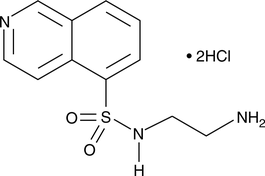Chemicals
Showing 21601–21750 of 41137 results
-
Protein kinase A (PKA) regulates multiple signal transduction events via protein phosphorylation and is integral to all cellular responses involving the cyclic AMP second messenger system. H-89 is a potent, cell permeable inhibitor of PKA that demonstrates an IC50 value of 0.14 µM and a Ki value of 48 nM in standard kinase assays.{12847,16039} While widely used to disrupt PKA signaling, the inhibitory activity of H-89 is non-selective. H-89 also inhibits S6K1, MSK1, ROCK-II, PKBα, and MAPKAP-K1b with IC50 values of 0.08, 0.12, 0.27, 2.6, and 2.8 µM, respectively.{12847}
Brand:CaymanSKU:10010556 - 10 mgAvailable on backorder
Protein kinase A (PKA) regulates multiple signal transduction events via protein phosphorylation and is integral to all cellular responses involving the cyclic AMP second messenger system. H-89 is a potent, cell permeable inhibitor of PKA that demonstrates an IC50 value of 0.14 µM and a Ki value of 48 nM in standard kinase assays.{12847,16039} While widely used to disrupt PKA signaling, the inhibitory activity of H-89 is non-selective. H-89 also inhibits S6K1, MSK1, ROCK-II, PKBα, and MAPKAP-K1b with IC50 values of 0.08, 0.12, 0.27, 2.6, and 2.8 µM, respectively.{12847}
Brand:CaymanSKU:10010556 - 25 mgAvailable on backorder
Protein kinase A (PKA) regulates multiple signal transduction events via protein phosphorylation and is integral to all cellular responses involving the cyclic AMP second messenger system. H-89 is a potent, cell permeable inhibitor of PKA that demonstrates an IC50 value of 0.14 µM and a Ki value of 48 nM in standard kinase assays.{12847,16039} While widely used to disrupt PKA signaling, the inhibitory activity of H-89 is non-selective. H-89 also inhibits S6K1, MSK1, ROCK-II, PKBα, and MAPKAP-K1b with IC50 values of 0.08, 0.12, 0.27, 2.6, and 2.8 µM, respectively.{12847}
Brand:CaymanSKU:10010556 - 5 mgAvailable on backorder
Protein kinase A (PKA) regulates multiple signal transduction events via protein phosphorylation and is integral to all cellular responses involving the cyclic AMP second messenger system. H-89 is a potent, cell permeable inhibitor of PKA that demonstrates an IC50 value of 0.14 µM and a Ki value of 48 nM in standard kinase assays.{12847,16039} While widely used to disrupt PKA signaling, the inhibitory activity of H-89 is non-selective. H-89 also inhibits S6K1, MSK1, ROCK-II, PKBα, and MAPKAP-K1b with IC50 values of 0.08, 0.12, 0.27, 2.6, and 2.8 µM, respectively.{12847}
Brand:CaymanSKU:10010556 - 50 mgAvailable on backorder
The H series isoquinolinesulfonamide protein kinase inhibitors are widely used to block signaling pathways in order to elucidate mechanisms of cellular regulation and signal transduction. H-9 (hydrochloride), an isoquinolinesulfonamide protein kinase inhibitor, is a competitive inhibitor of PKC, PKG, and PKA with Ki values of 18, 0.87, and 1.9 µM, respectively.{16079} H-9 (hydrochloride) has been used to reduce the cAMP-mediated excitatory response to serotonin in C. elegans enteric neurons{17222} and to inhibit PKA-mediated phosphorylation in a rat seizure model.{17221}
Brand:CaymanSKU:-The H series isoquinolinesulfonamide protein kinase inhibitors are widely used to block signaling pathways in order to elucidate mechanisms of cellular regulation and signal transduction. H-9 (hydrochloride), an isoquinolinesulfonamide protein kinase inhibitor, is a competitive inhibitor of PKC, PKG, and PKA with Ki values of 18, 0.87, and 1.9 µM, respectively.{16079} H-9 (hydrochloride) has been used to reduce the cAMP-mediated excitatory response to serotonin in C. elegans enteric neurons{17222} and to inhibit PKA-mediated phosphorylation in a rat seizure model.{17221}
Brand:CaymanSKU:-The H series isoquinolinesulfonamide protein kinase inhibitors are widely used to block signaling pathways in order to elucidate mechanisms of cellular regulation and signal transduction. H-9 (hydrochloride), an isoquinolinesulfonamide protein kinase inhibitor, is a competitive inhibitor of PKC, PKG, and PKA with Ki values of 18, 0.87, and 1.9 µM, respectively.{16079} H-9 (hydrochloride) has been used to reduce the cAMP-mediated excitatory response to serotonin in C. elegans enteric neurons{17222} and to inhibit PKA-mediated phosphorylation in a rat seizure model.{17221}
Brand:CaymanSKU:-The H series isoquinolinesulfonamide protein kinase inhibitors are widely used to block signaling pathways in order to elucidate mechanisms of cellular regulation and signal transduction. H-9 (hydrochloride), an isoquinolinesulfonamide protein kinase inhibitor, is a competitive inhibitor of PKC, PKG, and PKA with Ki values of 18, 0.87, and 1.9 µM, respectively.{16079} H-9 (hydrochloride) has been used to reduce the cAMP-mediated excitatory response to serotonin in C. elegans enteric neurons{17222} and to inhibit PKA-mediated phosphorylation in a rat seizure model.{17221}
Brand:CaymanSKU:-H-Gly-Arg-pNA is a colorimetric substrate for thrombin.{51139,51140} Thrombin preferentially binds to and cleaves the Gly-Arg (GR) peptide sequence to release p-nitroanilide (pNA), which can be quantified by colorimetric detection at 405 nm as a measure of thrombin activity.
Brand:CaymanSKU:27705 - 1 mgAvailable on backorder
H-Gly-Arg-pNA is a colorimetric substrate for thrombin.{51139,51140} Thrombin preferentially binds to and cleaves the Gly-Arg (GR) peptide sequence to release p-nitroanilide (pNA), which can be quantified by colorimetric detection at 405 nm as a measure of thrombin activity.
Brand:CaymanSKU:27705 - 10 mgAvailable on backorder
H-Gly-Arg-pNA is a colorimetric substrate for thrombin.{51139,51140} Thrombin preferentially binds to and cleaves the Gly-Arg (GR) peptide sequence to release p-nitroanilide (pNA), which can be quantified by colorimetric detection at 405 nm as a measure of thrombin activity.
Brand:CaymanSKU:27705 - 25 mgAvailable on backorder
H-Gly-Arg-pNA is a colorimetric substrate for thrombin.{51139,51140} Thrombin preferentially binds to and cleaves the Gly-Arg (GR) peptide sequence to release p-nitroanilide (pNA), which can be quantified by colorimetric detection at 405 nm as a measure of thrombin activity.
Brand:CaymanSKU:27705 - 5 mgAvailable on backorder
H-Gly-Pro-Arg-Pro-OH (GPRP) is a peptide corresponding partly to the amino terminus of the Aα chain and Bβ chain of fibrin. It inhibits the spontaneous polymerization of fibrin monomers and also inhibits ADP-induced platelet aggregation (IC50 = 3 mM).{33274,33275,33276} GPRP binds to the fibrinogen D domain, inhibiting the ability of fibrinogen to bind to the platelet membrane glycoprotein GPIIb/IIIa.{33274,33275}
Brand:CaymanSKU:21163 -Out of stock
H-Gly-Pro-Arg-Pro-OH (GPRP) is a peptide corresponding partly to the amino terminus of the Aα chain and Bβ chain of fibrin. It inhibits the spontaneous polymerization of fibrin monomers and also inhibits ADP-induced platelet aggregation (IC50 = 3 mM).{33274,33275,33276} GPRP binds to the fibrinogen D domain, inhibiting the ability of fibrinogen to bind to the platelet membrane glycoprotein GPIIb/IIIa.{33274,33275}
Brand:CaymanSKU:21163 -Out of stock
H-Gly-Pro-Arg-Pro-OH (GPRP) is a peptide corresponding partly to the amino terminus of the Aα chain and Bβ chain of fibrin. It inhibits the spontaneous polymerization of fibrin monomers and also inhibits ADP-induced platelet aggregation (IC50 = 3 mM).{33274,33275,33276} GPRP binds to the fibrinogen D domain, inhibiting the ability of fibrinogen to bind to the platelet membrane glycoprotein GPIIb/IIIa.{33274,33275}
Brand:CaymanSKU:21163 -Out of stock
H-Gly-Pro-Arg-Pro-OH (GPRP) is a peptide corresponding partly to the amino terminus of the Aα chain and Bβ chain of fibrin. It inhibits the spontaneous polymerization of fibrin monomers and also inhibits ADP-induced platelet aggregation (IC50 = 3 mM).{33274,33275,33276} GPRP binds to the fibrinogen D domain, inhibiting the ability of fibrinogen to bind to the platelet membrane glycoprotein GPIIb/IIIa.{33274,33275}
Brand:CaymanSKU:21163 -Out of stock
H2L5186303 is a selective lysophosphatidic acid 2 (LPA2) receptor antagonist (IC50 = 9 nM in a LPA-elicited calcium mobilization assay).{32496} It inhibits LPA1 and LPA3 at much higher concentrations (IC50s = 27,354 and 4,504 nM, respectively).{32496}
Brand:CaymanSKU:-H2L5186303 is a selective lysophosphatidic acid 2 (LPA2) receptor antagonist (IC50 = 9 nM in a LPA-elicited calcium mobilization assay).{32496} It inhibits LPA1 and LPA3 at much higher concentrations (IC50s = 27,354 and 4,504 nM, respectively).{32496}
Brand:CaymanSKU:-H2L5186303 is a selective lysophosphatidic acid 2 (LPA2) receptor antagonist (IC50 = 9 nM in a LPA-elicited calcium mobilization assay).{32496} It inhibits LPA1 and LPA3 at much higher concentrations (IC50s = 27,354 and 4,504 nM, respectively).{32496}
Brand:CaymanSKU:-H2L5186303 is a selective lysophosphatidic acid 2 (LPA2) receptor antagonist (IC50 = 9 nM in a LPA-elicited calcium mobilization assay).{32496} It inhibits LPA1 and LPA3 at much higher concentrations (IC50s = 27,354 and 4,504 nM, respectively).{32496}
Brand:CaymanSKU:-H2S Donor 5a is a stable, cysteine-activated H2S donor. In the presence of excess of cysteine, the concentration of H2S released from this compound reaches a maximum value at 18 min.{20280} It does not react with potential cellular nucleophiles such as -OH and -NH2 groups.{20280}
Brand:CaymanSKU:11238 - 1 mgAvailable on backorder
H2S Donor 5a is a stable, cysteine-activated H2S donor. In the presence of excess of cysteine, the concentration of H2S released from this compound reaches a maximum value at 18 min.{20280} It does not react with potential cellular nucleophiles such as -OH and -NH2 groups.{20280}
Brand:CaymanSKU:11238 - 10 mgAvailable on backorder
H2S Donor 5a is a stable, cysteine-activated H2S donor. In the presence of excess of cysteine, the concentration of H2S released from this compound reaches a maximum value at 18 min.{20280} It does not react with potential cellular nucleophiles such as -OH and -NH2 groups.{20280}
Brand:CaymanSKU:11238 - 25 mgAvailable on backorder
H2S Donor 5a is a stable, cysteine-activated H2S donor. In the presence of excess of cysteine, the concentration of H2S released from this compound reaches a maximum value at 18 min.{20280} It does not react with potential cellular nucleophiles such as -OH and -NH2 groups.{20280}
Brand:CaymanSKU:11238 - 5 mgAvailable on backorder
H3B-5942 is a selective estrogen receptor covalent antagonist (SERCA).{57227} It covalently modifies cysteine 530 in the ligand binding domain of wild-type estrogen receptor α (ERα) and ERαY537S. HB-5942 inhibits expression of the ERα target genes GREB1 and TFF1 in MCF-7 cells overexpressing wild-type ERα (IC50s = 2.74 and 1.3 nM, respectively) or the mutant receptors ERαY537S (IC50s = 29.38 and 19.4 nM, respectively), ERαY537N (IC50s = 8.14 and 6.1 nM, respectively), ERαY537C (IC50s = 12.19 and 9.5 nM, respectively), or ERαD538G (IC50s = 24.87 and 4 nM, respectively), which are active independent of estradiol. It inhibits the growth of MCF-7 cells overexpressing wild-type ERα or ERαY537S (GI50s = 1.3 and 8.3 nM, respectively). H3B-5942 reduces tumor growth in an MCF-7 mouse xenograft model and an ERαY537S/WT ST941 patient-derived xenograft (PDX) mouse model in a dose-dependent manner.
Brand:CaymanSKU:31454 - 1 mgAvailable on backorder
H3B-5942 is a selective estrogen receptor covalent antagonist (SERCA).{57227} It covalently modifies cysteine 530 in the ligand binding domain of wild-type estrogen receptor α (ERα) and ERαY537S. HB-5942 inhibits expression of the ERα target genes GREB1 and TFF1 in MCF-7 cells overexpressing wild-type ERα (IC50s = 2.74 and 1.3 nM, respectively) or the mutant receptors ERαY537S (IC50s = 29.38 and 19.4 nM, respectively), ERαY537N (IC50s = 8.14 and 6.1 nM, respectively), ERαY537C (IC50s = 12.19 and 9.5 nM, respectively), or ERαD538G (IC50s = 24.87 and 4 nM, respectively), which are active independent of estradiol. It inhibits the growth of MCF-7 cells overexpressing wild-type ERα or ERαY537S (GI50s = 1.3 and 8.3 nM, respectively). H3B-5942 reduces tumor growth in an MCF-7 mouse xenograft model and an ERαY537S/WT ST941 patient-derived xenograft (PDX) mouse model in a dose-dependent manner.
Brand:CaymanSKU:31454 - 10 mgAvailable on backorder
H3B-5942 is a selective estrogen receptor covalent antagonist (SERCA).{57227} It covalently modifies cysteine 530 in the ligand binding domain of wild-type estrogen receptor α (ERα) and ERαY537S. HB-5942 inhibits expression of the ERα target genes GREB1 and TFF1 in MCF-7 cells overexpressing wild-type ERα (IC50s = 2.74 and 1.3 nM, respectively) or the mutant receptors ERαY537S (IC50s = 29.38 and 19.4 nM, respectively), ERαY537N (IC50s = 8.14 and 6.1 nM, respectively), ERαY537C (IC50s = 12.19 and 9.5 nM, respectively), or ERαD538G (IC50s = 24.87 and 4 nM, respectively), which are active independent of estradiol. It inhibits the growth of MCF-7 cells overexpressing wild-type ERα or ERαY537S (GI50s = 1.3 and 8.3 nM, respectively). H3B-5942 reduces tumor growth in an MCF-7 mouse xenograft model and an ERαY537S/WT ST941 patient-derived xenograft (PDX) mouse model in a dose-dependent manner.
Brand:CaymanSKU:31454 - 25 mgAvailable on backorder
H3B-5942 is a selective estrogen receptor covalent antagonist (SERCA).{57227} It covalently modifies cysteine 530 in the ligand binding domain of wild-type estrogen receptor α (ERα) and ERαY537S. HB-5942 inhibits expression of the ERα target genes GREB1 and TFF1 in MCF-7 cells overexpressing wild-type ERα (IC50s = 2.74 and 1.3 nM, respectively) or the mutant receptors ERαY537S (IC50s = 29.38 and 19.4 nM, respectively), ERαY537N (IC50s = 8.14 and 6.1 nM, respectively), ERαY537C (IC50s = 12.19 and 9.5 nM, respectively), or ERαD538G (IC50s = 24.87 and 4 nM, respectively), which are active independent of estradiol. It inhibits the growth of MCF-7 cells overexpressing wild-type ERα or ERαY537S (GI50s = 1.3 and 8.3 nM, respectively). H3B-5942 reduces tumor growth in an MCF-7 mouse xenograft model and an ERαY537S/WT ST941 patient-derived xenograft (PDX) mouse model in a dose-dependent manner.
Brand:CaymanSKU:31454 - 5 mgAvailable on backorder
H3B-6527 is an inhibitor of FGF receptor 4 (FGFR4; IC50 = 50s = 320, 1,290, and 1,060 nM, respectively), as well as TAOK2, JNK2, and CSF1R (IC50s = 690, >10,000, and >10,000 nM, respectively). H3B-6527 increases the expression of the cytochrome P450 (CYP) isoform CYP7A1 and decreases phosphorylation of ERK1/2 in Hep3B hepatocellular carcinoma (HCC) cells in a concentration-dependent manner, indicating inhibition of the FGF19-FGFR4 signaling pathway. It also decreases cell growth (GI50 = 25 nM) and increases caspase-3/7 activity in Hep3B HCC cells. H3B-6527 selectively inhibits cell growth in HCC cell lines that express high levels of FGF19 and have high FGF19 protein levels. It reduces tumor growth in a Hep3B HCC mouse xenograft model, when administered at doses of 100 and 300 mg/kg, and in patient-derived xenograft models with high FGF19 expression. H3B-6527, in combination with PD 0332991 (palbociclib; Item No. 16273), induces tumor stasis in a JHH-7 mouse xenograft model.
Brand:CaymanSKU:26072 - 1 mgAvailable on backorder
H3B-6527 is an inhibitor of FGF receptor 4 (FGFR4; IC50 = 50s = 320, 1,290, and 1,060 nM, respectively), as well as TAOK2, JNK2, and CSF1R (IC50s = 690, >10,000, and >10,000 nM, respectively). H3B-6527 increases the expression of the cytochrome P450 (CYP) isoform CYP7A1 and decreases phosphorylation of ERK1/2 in Hep3B hepatocellular carcinoma (HCC) cells in a concentration-dependent manner, indicating inhibition of the FGF19-FGFR4 signaling pathway. It also decreases cell growth (GI50 = 25 nM) and increases caspase-3/7 activity in Hep3B HCC cells. H3B-6527 selectively inhibits cell growth in HCC cell lines that express high levels of FGF19 and have high FGF19 protein levels. It reduces tumor growth in a Hep3B HCC mouse xenograft model, when administered at doses of 100 and 300 mg/kg, and in patient-derived xenograft models with high FGF19 expression. H3B-6527, in combination with PD 0332991 (palbociclib; Item No. 16273), induces tumor stasis in a JHH-7 mouse xenograft model.
Brand:CaymanSKU:26072 - 10 mgAvailable on backorder
H3B-6527 is an inhibitor of FGF receptor 4 (FGFR4; IC50 = 50s = 320, 1,290, and 1,060 nM, respectively), as well as TAOK2, JNK2, and CSF1R (IC50s = 690, >10,000, and >10,000 nM, respectively). H3B-6527 increases the expression of the cytochrome P450 (CYP) isoform CYP7A1 and decreases phosphorylation of ERK1/2 in Hep3B hepatocellular carcinoma (HCC) cells in a concentration-dependent manner, indicating inhibition of the FGF19-FGFR4 signaling pathway. It also decreases cell growth (GI50 = 25 nM) and increases caspase-3/7 activity in Hep3B HCC cells. H3B-6527 selectively inhibits cell growth in HCC cell lines that express high levels of FGF19 and have high FGF19 protein levels. It reduces tumor growth in a Hep3B HCC mouse xenograft model, when administered at doses of 100 and 300 mg/kg, and in patient-derived xenograft models with high FGF19 expression. H3B-6527, in combination with PD 0332991 (palbociclib; Item No. 16273), induces tumor stasis in a JHH-7 mouse xenograft model.
Brand:CaymanSKU:26072 - 25 mgAvailable on backorder
H3B-6527 is an inhibitor of FGF receptor 4 (FGFR4; IC50 = 50s = 320, 1,290, and 1,060 nM, respectively), as well as TAOK2, JNK2, and CSF1R (IC50s = 690, >10,000, and >10,000 nM, respectively). H3B-6527 increases the expression of the cytochrome P450 (CYP) isoform CYP7A1 and decreases phosphorylation of ERK1/2 in Hep3B hepatocellular carcinoma (HCC) cells in a concentration-dependent manner, indicating inhibition of the FGF19-FGFR4 signaling pathway. It also decreases cell growth (GI50 = 25 nM) and increases caspase-3/7 activity in Hep3B HCC cells. H3B-6527 selectively inhibits cell growth in HCC cell lines that express high levels of FGF19 and have high FGF19 protein levels. It reduces tumor growth in a Hep3B HCC mouse xenograft model, when administered at doses of 100 and 300 mg/kg, and in patient-derived xenograft models with high FGF19 expression. H3B-6527, in combination with PD 0332991 (palbociclib; Item No. 16273), induces tumor stasis in a JHH-7 mouse xenograft model.
Brand:CaymanSKU:26072 - 5 mgAvailable on backorder
HA-100 is an isoquinoline compound with an added piperazinylsulfonyl group that acts as an inhibitor of protein kinases (PKs), including PKA, PKC, and PKG (IC50s = 8, 12, and 4 µM, respectively).{24251} It less effectively blocks the activity of myosin light chain kinase (IC50 = 240 µM).{24251}
Brand:CaymanSKU:-HA-100 is an isoquinoline compound with an added piperazinylsulfonyl group that acts as an inhibitor of protein kinases (PKs), including PKA, PKC, and PKG (IC50s = 8, 12, and 4 µM, respectively).{24251} It less effectively blocks the activity of myosin light chain kinase (IC50 = 240 µM).{24251}
Brand:CaymanSKU:-HA-100 is an isoquinoline compound with an added piperazinylsulfonyl group that acts as an inhibitor of protein kinases (PKs), including PKA, PKC, and PKG (IC50s = 8, 12, and 4 µM, respectively).{24251} It less effectively blocks the activity of myosin light chain kinase (IC50 = 240 µM).{24251}
Brand:CaymanSKU:-HA-100 is an isoquinoline compound with an added piperazinylsulfonyl group that acts as an inhibitor of protein kinases (PKs), including PKA, PKC, and PKG (IC50s = 8, 12, and 4 µM, respectively).{24251} It less effectively blocks the activity of myosin light chain kinase (IC50 = 240 µM).{24251}
Brand:CaymanSKU:-HA-1004 is an inhibitor of protein kinase G (PKG) and PKA (Kis = 1.4 and 2.3 µM, respectively).{48086} It also inhibits PKC and blocks intracellular calcium mobilization.{48087,48088} HA-1004 induces relaxation of isolated rabbit aortic strips precontracted with histamine, serotonin (Item No. 14332), A23187 (Item No. 11016), angiotensin II (Item No. 17150), or prostaglandin F2α (Item No. 16010; EC50s = 0.32-0.63 µM), as well as phenylephrine (Item Nos. 18619 | 17205) with or without calcium (EC50s = 2.3 and 0.5 µM, respectively). It also inhibits histamine-induced bronchoconstriction in guinea pigs without affecting blood pressure when administered intratracheally at a dose of 0.1 mg per animal.{48087}
Brand:CaymanSKU:10010558 - 10 mgAvailable on backorder
HA-1004 is an inhibitor of protein kinase G (PKG) and PKA (Kis = 1.4 and 2.3 µM, respectively).{48086} It also inhibits PKC and blocks intracellular calcium mobilization.{48087,48088} HA-1004 induces relaxation of isolated rabbit aortic strips precontracted with histamine, serotonin (Item No. 14332), A23187 (Item No. 11016), angiotensin II (Item No. 17150), or prostaglandin F2α (Item No. 16010; EC50s = 0.32-0.63 µM), as well as phenylephrine (Item Nos. 18619 | 17205) with or without calcium (EC50s = 2.3 and 0.5 µM, respectively). It also inhibits histamine-induced bronchoconstriction in guinea pigs without affecting blood pressure when administered intratracheally at a dose of 0.1 mg per animal.{48087}
Brand:CaymanSKU:10010558 - 5 mgAvailable on backorder
Rho-associated kinase (ROCK), an effector of the small GTP-binding protein Rho, plays an important role in various cellular functions including vascular smooth muscle contraction, proliferation, and migration as well as inflammatory cell mobility.{16260} HA-1077 is a potent inhibitor of ROCK-II and additionally inhibits protein kinase c-related kinase 2 (PRK2), mitogen- and stress-activated protein kinase (MSK1), and mitogen activated protein kinase-activated protein kinase 1b (MAPKAP-K1b) with IC50 values of 1.9, 4, 5, and 15 µM, respectively.{12847} By inhibiting the activity of ROCK, HA-1077 has been shown to reduce blood vessel constriction, decrease pulmonary arterial pressure, inhibit tumor angiogenesis, and improve insulin signaling in various rodent models.{16259,16257,16258} While originally marketed for the prevention of cerebral vasospasm in patients with subarachnoid hemorrhage, oral formulations of HA-1077 are used for the treatment of a wide range of cardiovascular diseases including pulmonary arterial hypertension and stable angina.
Brand:CaymanSKU:10010559 - 10 mgAvailable on backorder
Rho-associated kinase (ROCK), an effector of the small GTP-binding protein Rho, plays an important role in various cellular functions including vascular smooth muscle contraction, proliferation, and migration as well as inflammatory cell mobility.{16260} HA-1077 is a potent inhibitor of ROCK-II and additionally inhibits protein kinase c-related kinase 2 (PRK2), mitogen- and stress-activated protein kinase (MSK1), and mitogen activated protein kinase-activated protein kinase 1b (MAPKAP-K1b) with IC50 values of 1.9, 4, 5, and 15 µM, respectively.{12847} By inhibiting the activity of ROCK, HA-1077 has been shown to reduce blood vessel constriction, decrease pulmonary arterial pressure, inhibit tumor angiogenesis, and improve insulin signaling in various rodent models.{16259,16257,16258} While originally marketed for the prevention of cerebral vasospasm in patients with subarachnoid hemorrhage, oral formulations of HA-1077 are used for the treatment of a wide range of cardiovascular diseases including pulmonary arterial hypertension and stable angina.
Brand:CaymanSKU:10010559 - 100 mgAvailable on backorder
Rho-associated kinase (ROCK), an effector of the small GTP-binding protein Rho, plays an important role in various cellular functions including vascular smooth muscle contraction, proliferation, and migration as well as inflammatory cell mobility.{16260} HA-1077 is a potent inhibitor of ROCK-II and additionally inhibits protein kinase c-related kinase 2 (PRK2), mitogen- and stress-activated protein kinase (MSK1), and mitogen activated protein kinase-activated protein kinase 1b (MAPKAP-K1b) with IC50 values of 1.9, 4, 5, and 15 µM, respectively.{12847} By inhibiting the activity of ROCK, HA-1077 has been shown to reduce blood vessel constriction, decrease pulmonary arterial pressure, inhibit tumor angiogenesis, and improve insulin signaling in various rodent models.{16259,16257,16258} While originally marketed for the prevention of cerebral vasospasm in patients with subarachnoid hemorrhage, oral formulations of HA-1077 are used for the treatment of a wide range of cardiovascular diseases including pulmonary arterial hypertension and stable angina.
Brand:CaymanSKU:10010559 - 50 mgAvailable on backorder
HA-1100, a cell-permeable hydroxylated metabolite of HA-1077 (Item No. 10010559), is a potent inhibitor of Rho-associated kinase (ROCK) (Ki = 150 nM).{23184} It less effectively inhibits protein kinase A (Ki = 2.2 μM).{23184} It has been used to explore the role of ROCK in hypoxic and ischemic signaling as well as arterial relaxation.{23180,23181,23182,23183}
Brand:CaymanSKU:-HA-1100, a cell-permeable hydroxylated metabolite of HA-1077 (Item No. 10010559), is a potent inhibitor of Rho-associated kinase (ROCK) (Ki = 150 nM).{23184} It less effectively inhibits protein kinase A (Ki = 2.2 μM).{23184} It has been used to explore the role of ROCK in hypoxic and ischemic signaling as well as arterial relaxation.{23180,23181,23182,23183}
Brand:CaymanSKU:-HA-1100, a cell-permeable hydroxylated metabolite of HA-1077 (Item No. 10010559), is a potent inhibitor of Rho-associated kinase (ROCK) (Ki = 150 nM).{23184} It less effectively inhibits protein kinase A (Ki = 2.2 μM).{23184} It has been used to explore the role of ROCK in hypoxic and ischemic signaling as well as arterial relaxation.{23180,23181,23182,23183}
Brand:CaymanSKU:-HA-1100, a cell-permeable hydroxylated metabolite of HA-1077 (Item No. 10010559), is a potent inhibitor of Rho-associated kinase (ROCK) (Ki = 150 nM).{23184} It less effectively inhibits protein kinase A (Ki = 2.2 μM).{23184} It has been used to explore the role of ROCK in hypoxic and ischemic signaling as well as arterial relaxation.{23180,23181,23182,23183}
Brand:CaymanSKU:-HA-130 is a reversible inhibitor of autotaxin, completely blocking the hydrolysis of the substrate bis-pNPP with an IC50 value of 28 nM.{18138} It does not affect the activity of any proteasomal protease or related enzymes. HA-130 rapidly decreases plasma lysophosphatidic acid levels in mice when given intravenously (1 nM/g).{18138} HA-130 has been used to investigate the role of autotaxin in cells and animals.{31823,31824,31825}
Brand:CaymanSKU:10498 - 10 mgAvailable on backorder
HA-130 is a reversible inhibitor of autotaxin, completely blocking the hydrolysis of the substrate bis-pNPP with an IC50 value of 28 nM.{18138} It does not affect the activity of any proteasomal protease or related enzymes. HA-130 rapidly decreases plasma lysophosphatidic acid levels in mice when given intravenously (1 nM/g).{18138} HA-130 has been used to investigate the role of autotaxin in cells and animals.{31823,31824,31825}
Brand:CaymanSKU:10498 - 25 mgAvailable on backorder
HA-130 is a reversible inhibitor of autotaxin, completely blocking the hydrolysis of the substrate bis-pNPP with an IC50 value of 28 nM.{18138} It does not affect the activity of any proteasomal protease or related enzymes. HA-130 rapidly decreases plasma lysophosphatidic acid levels in mice when given intravenously (1 nM/g).{18138} HA-130 has been used to investigate the role of autotaxin in cells and animals.{31823,31824,31825}
Brand:CaymanSKU:10498 - 5 mgAvailable on backorder
HA-14-1 is a small molecule that binds the surface pocket of Bcl-2 proteins (IC50 = ~ 9 µM) and induces apoptosis by interfering with its interaction with the Bak peptide and activating Apaf-1 and caspase-9 and -3.{25684} It can also bind to the antiapoptotic Bcl-2 proteins Bcl-xl and Bcl-W.{25683} HA-14-1 has been shown to induce apoptosis of human acute myeloid leukemia (HL-60) cells (50 µM induces 90% loss of viability).{25684}
Brand:CaymanSKU:-HA-14-1 is a small molecule that binds the surface pocket of Bcl-2 proteins (IC50 = ~ 9 µM) and induces apoptosis by interfering with its interaction with the Bak peptide and activating Apaf-1 and caspase-9 and -3.{25684} It can also bind to the antiapoptotic Bcl-2 proteins Bcl-xl and Bcl-W.{25683} HA-14-1 has been shown to induce apoptosis of human acute myeloid leukemia (HL-60) cells (50 µM induces 90% loss of viability).{25684}
Brand:CaymanSKU:-HA-14-1 is a small molecule that binds the surface pocket of Bcl-2 proteins (IC50 = ~ 9 µM) and induces apoptosis by interfering with its interaction with the Bak peptide and activating Apaf-1 and caspase-9 and -3.{25684} It can also bind to the antiapoptotic Bcl-2 proteins Bcl-xl and Bcl-W.{25683} HA-14-1 has been shown to induce apoptosis of human acute myeloid leukemia (HL-60) cells (50 µM induces 90% loss of viability).{25684}
Brand:CaymanSKU:-HA-14-1 is a small molecule that binds the surface pocket of Bcl-2 proteins (IC50 = ~ 9 µM) and induces apoptosis by interfering with its interaction with the Bak peptide and activating Apaf-1 and caspase-9 and -3.{25684} It can also bind to the antiapoptotic Bcl-2 proteins Bcl-xl and Bcl-W.{25683} HA-14-1 has been shown to induce apoptosis of human acute myeloid leukemia (HL-60) cells (50 µM induces 90% loss of viability).{25684}
Brand:CaymanSKU:-Autotaxin converts lysophosphatidylcholine to lysophosphatidic acid (LPA), which can mediate changes in cell proliferation, angiogenesis, and cytokine secretion. HA-155 is a boronic acid-based compound that inhibits autotaxin (IC50 = 5.7 nM) by selectively binding to its catalytic threonine.{19277,28701} It has been shown to dose-dependently block thrombin-induced LPA secretion in platelets.{28702}
Brand:CaymanSKU:11034 - 1 mgAvailable on backorder
Autotaxin converts lysophosphatidylcholine to lysophosphatidic acid (LPA), which can mediate changes in cell proliferation, angiogenesis, and cytokine secretion. HA-155 is a boronic acid-based compound that inhibits autotaxin (IC50 = 5.7 nM) by selectively binding to its catalytic threonine.{19277,28701} It has been shown to dose-dependently block thrombin-induced LPA secretion in platelets.{28702}
Brand:CaymanSKU:11034 - 10 mgAvailable on backorder
Autotaxin converts lysophosphatidylcholine to lysophosphatidic acid (LPA), which can mediate changes in cell proliferation, angiogenesis, and cytokine secretion. HA-155 is a boronic acid-based compound that inhibits autotaxin (IC50 = 5.7 nM) by selectively binding to its catalytic threonine.{19277,28701} It has been shown to dose-dependently block thrombin-induced LPA secretion in platelets.{28702}
Brand:CaymanSKU:11034 - 25 mgAvailable on backorder
Autotaxin converts lysophosphatidylcholine to lysophosphatidic acid (LPA), which can mediate changes in cell proliferation, angiogenesis, and cytokine secretion. HA-155 is a boronic acid-based compound that inhibits autotaxin (IC50 = 5.7 nM) by selectively binding to its catalytic threonine.{19277,28701} It has been shown to dose-dependently block thrombin-induced LPA secretion in platelets.{28702}
Brand:CaymanSKU:11034 - 5 mgAvailable on backorder
Halcinonide is a synthetic glucocorticoid with anti-inflammatory properties.{40483,40484} In a rabbit model of edema, topical application of halcinonide (0.1% w/w) decreases edema by 55% in a reversed passive Arthus skin test (RPA).{40483} Halcinonide (0.1% w/w) inhibits croton oil-induced ear edema by 70.1% and homologous passive cutaneous anaphylaxis (PCA) by 88.0% in rats dosed three hours prior to induction of inflammation.{40484} Application of halcinonide (0.1% w/w) to the abraded surface of cecum in rats inhibits leukocyte adhesion (43.3% incidence versus 100% for controls) and lowers the total number of intraperitoneal leukocytes from 270 million to 121 million 3 days post surgery.{40485} It also acts as an agonist at the smoothened (Smo) receptor with an EC50 value of 1,100 nM.{40486} Formulations containing halcinonide have been used to treat inflammatory and corticosteroid-responsive dermatoses.
Brand:CaymanSKU:23780 - 10 mgAvailable on backorder
Halcinonide is a synthetic glucocorticoid with anti-inflammatory properties.{40483,40484} In a rabbit model of edema, topical application of halcinonide (0.1% w/w) decreases edema by 55% in a reversed passive Arthus skin test (RPA).{40483} Halcinonide (0.1% w/w) inhibits croton oil-induced ear edema by 70.1% and homologous passive cutaneous anaphylaxis (PCA) by 88.0% in rats dosed three hours prior to induction of inflammation.{40484} Application of halcinonide (0.1% w/w) to the abraded surface of cecum in rats inhibits leukocyte adhesion (43.3% incidence versus 100% for controls) and lowers the total number of intraperitoneal leukocytes from 270 million to 121 million 3 days post surgery.{40485} It also acts as an agonist at the smoothened (Smo) receptor with an EC50 value of 1,100 nM.{40486} Formulations containing halcinonide have been used to treat inflammatory and corticosteroid-responsive dermatoses.
Brand:CaymanSKU:23780 - 100 mgAvailable on backorder
Halcinonide is a synthetic glucocorticoid with anti-inflammatory properties.{40483,40484} In a rabbit model of edema, topical application of halcinonide (0.1% w/w) decreases edema by 55% in a reversed passive Arthus skin test (RPA).{40483} Halcinonide (0.1% w/w) inhibits croton oil-induced ear edema by 70.1% and homologous passive cutaneous anaphylaxis (PCA) by 88.0% in rats dosed three hours prior to induction of inflammation.{40484} Application of halcinonide (0.1% w/w) to the abraded surface of cecum in rats inhibits leukocyte adhesion (43.3% incidence versus 100% for controls) and lowers the total number of intraperitoneal leukocytes from 270 million to 121 million 3 days post surgery.{40485} It also acts as an agonist at the smoothened (Smo) receptor with an EC50 value of 1,100 nM.{40486} Formulations containing halcinonide have been used to treat inflammatory and corticosteroid-responsive dermatoses.
Brand:CaymanSKU:23780 - 25 mgAvailable on backorder
Halcinonide is a synthetic glucocorticoid with anti-inflammatory properties.{40483,40484} In a rabbit model of edema, topical application of halcinonide (0.1% w/w) decreases edema by 55% in a reversed passive Arthus skin test (RPA).{40483} Halcinonide (0.1% w/w) inhibits croton oil-induced ear edema by 70.1% and homologous passive cutaneous anaphylaxis (PCA) by 88.0% in rats dosed three hours prior to induction of inflammation.{40484} Application of halcinonide (0.1% w/w) to the abraded surface of cecum in rats inhibits leukocyte adhesion (43.3% incidence versus 100% for controls) and lowers the total number of intraperitoneal leukocytes from 270 million to 121 million 3 days post surgery.{40485} It also acts as an agonist at the smoothened (Smo) receptor with an EC50 value of 1,100 nM.{40486} Formulations containing halcinonide have been used to treat inflammatory and corticosteroid-responsive dermatoses.
Brand:CaymanSKU:23780 - 50 mgAvailable on backorder
Halobetasol propionate is a synthetic glucocorticoid.{41241} It inhibits dermatitis induced by ultraviolet light in guinea pigs (ED50 = 1.45 µg/animal) and by oxazolone in mice (ED50 = 0.8 µg/animal).{36326} Halobetasol propionate also has anti-inflammatory effects on croton oil-induced ear edema in rats (ED50s = 10 µg/ml and 0.5 µg/ear) and mice (ED50s = 1.2 and <0.32 µg/ear after 6 and 24 hours of treatment, respectively). Topical formulations containing halobetasol propionate have been used for inflammatory and pruritic dermatitis.
Brand:CaymanSKU:23781 - 10 mgAvailable on backorder
Halobetasol propionate is a synthetic glucocorticoid.{41241} It inhibits dermatitis induced by ultraviolet light in guinea pigs (ED50 = 1.45 µg/animal) and by oxazolone in mice (ED50 = 0.8 µg/animal).{36326} Halobetasol propionate also has anti-inflammatory effects on croton oil-induced ear edema in rats (ED50s = 10 µg/ml and 0.5 µg/ear) and mice (ED50s = 1.2 and <0.32 µg/ear after 6 and 24 hours of treatment, respectively). Topical formulations containing halobetasol propionate have been used for inflammatory and pruritic dermatitis.
Brand:CaymanSKU:23781 - 25 mgAvailable on backorder
Halobetasol propionate is a synthetic glucocorticoid.{41241} It inhibits dermatitis induced by ultraviolet light in guinea pigs (ED50 = 1.45 µg/animal) and by oxazolone in mice (ED50 = 0.8 µg/animal).{36326} Halobetasol propionate also has anti-inflammatory effects on croton oil-induced ear edema in rats (ED50s = 10 µg/ml and 0.5 µg/ear) and mice (ED50s = 1.2 and <0.32 µg/ear after 6 and 24 hours of treatment, respectively). Topical formulations containing halobetasol propionate have been used for inflammatory and pruritic dermatitis.
Brand:CaymanSKU:23781 - 5 mgAvailable on backorder
Halobetasol propionate is a synthetic glucocorticoid.{41241} It inhibits dermatitis induced by ultraviolet light in guinea pigs (ED50 = 1.45 µg/animal) and by oxazolone in mice (ED50 = 0.8 µg/animal).{36326} Halobetasol propionate also has anti-inflammatory effects on croton oil-induced ear edema in rats (ED50s = 10 µg/ml and 0.5 µg/ear) and mice (ED50s = 1.2 and <0.32 µg/ear after 6 and 24 hours of treatment, respectively). Topical formulations containing halobetasol propionate have been used for inflammatory and pruritic dermatitis.
Brand:CaymanSKU:23781 - 50 mgAvailable on backorder
Halofantrine is an antimalarial agent.{52644} It is active against chloroquine-sensitive and chloroquine-resistant strains of P. falciparum (IC50s = 1.5-2.5 and 1.3-3.9 µg/L, respectively). Halofantrine reduces parasitemia in a mouse model of P. berghei infection with a 50% curative dose (CD50) value of 15 mg/kg. It also reduces parasitemia in an Aotus monkey model of P. falciparum infection (CD50 = 58.3 mg/kg). Formulations containing halofantrine have been used in the treatment of malaria.
Brand:CaymanSKU:30962 - 1 mgAvailable on backorder
Halofantrine is an antimalarial agent.{52644} It is active against chloroquine-sensitive and chloroquine-resistant strains of P. falciparum (IC50s = 1.5-2.5 and 1.3-3.9 µg/L, respectively). Halofantrine reduces parasitemia in a mouse model of P. berghei infection with a 50% curative dose (CD50) value of 15 mg/kg. It also reduces parasitemia in an Aotus monkey model of P. falciparum infection (CD50 = 58.3 mg/kg). Formulations containing halofantrine have been used in the treatment of malaria.
Brand:CaymanSKU:30962 - 10 mgAvailable on backorder
Halofantrine is an antimalarial agent.{52644} It is active against chloroquine-sensitive and chloroquine-resistant strains of P. falciparum (IC50s = 1.5-2.5 and 1.3-3.9 µg/L, respectively). Halofantrine reduces parasitemia in a mouse model of P. berghei infection with a 50% curative dose (CD50) value of 15 mg/kg. It also reduces parasitemia in an Aotus monkey model of P. falciparum infection (CD50 = 58.3 mg/kg). Formulations containing halofantrine have been used in the treatment of malaria.
Brand:CaymanSKU:30962 - 5 mgAvailable on backorder
Halofuginone is a halogenated derivative of febrifugine, a natural quinazolinone-containing compound found in the Chinese herb D. febrifuga.{26479} It has antimalarial and anticoccidial actions.{26479} In mammals, halofuginone at 10 ng/ml down-regulates Smad3, blocking TGF-β signaling and preventing both the differentiation of fibroblasts to myofibroblasts and the transitioning of epithelial cells to mesenchymal cells.{26479,26481} Through this action, halofuginone blocks fibrosis and tumor progression in a variety of different models.{26479,26482} This compound also competitively inhibits prolyl-tRNA synthetase (Ki = 18.3 nM), activating the amino acid starvation response.{26480,17217} This prevents the differentiation of TH17 cells, blunting an autoimmune response.{17217}
Brand:CaymanSKU:-Halofuginone is a halogenated derivative of febrifugine, a natural quinazolinone-containing compound found in the Chinese herb D. febrifuga.{26479} It has antimalarial and anticoccidial actions.{26479} In mammals, halofuginone at 10 ng/ml down-regulates Smad3, blocking TGF-β signaling and preventing both the differentiation of fibroblasts to myofibroblasts and the transitioning of epithelial cells to mesenchymal cells.{26479,26481} Through this action, halofuginone blocks fibrosis and tumor progression in a variety of different models.{26479,26482} This compound also competitively inhibits prolyl-tRNA synthetase (Ki = 18.3 nM), activating the amino acid starvation response.{26480,17217} This prevents the differentiation of TH17 cells, blunting an autoimmune response.{17217}
Brand:CaymanSKU:-Halofuginone is a halogenated derivative of febrifugine, a natural quinazolinone-containing compound found in the Chinese herb D. febrifuga.{26479} It has antimalarial and anticoccidial actions.{26479} In mammals, halofuginone at 10 ng/ml down-regulates Smad3, blocking TGF-β signaling and preventing both the differentiation of fibroblasts to myofibroblasts and the transitioning of epithelial cells to mesenchymal cells.{26479,26481} Through this action, halofuginone blocks fibrosis and tumor progression in a variety of different models.{26479,26482} This compound also competitively inhibits prolyl-tRNA synthetase (Ki = 18.3 nM), activating the amino acid starvation response.{26480,17217} This prevents the differentiation of TH17 cells, blunting an autoimmune response.{17217}
Brand:CaymanSKU:-Halopemide is a potent inhibitor of phospholipase D (PLD), inhibiting human PLD1 and PLD2 in vitro (IC50 = 220 and 310 nM, respectively) and PLD activity in cells.{16821} Previously, halopemide has been found to inhibit dopamine receptors and was evaluated as a neuroleptic agent.{17063}
Brand:CaymanSKU:-Halopemide is a potent inhibitor of phospholipase D (PLD), inhibiting human PLD1 and PLD2 in vitro (IC50 = 220 and 310 nM, respectively) and PLD activity in cells.{16821} Previously, halopemide has been found to inhibit dopamine receptors and was evaluated as a neuroleptic agent.{17063}
Brand:CaymanSKU:-Halopemide is a potent inhibitor of phospholipase D (PLD), inhibiting human PLD1 and PLD2 in vitro (IC50 = 220 and 310 nM, respectively) and PLD activity in cells.{16821} Previously, halopemide has been found to inhibit dopamine receptors and was evaluated as a neuroleptic agent.{17063}
Brand:CaymanSKU:-Halopemide is a potent inhibitor of phospholipase D (PLD), inhibiting human PLD1 and PLD2 in vitro (IC50 = 220 and 310 nM, respectively) and PLD activity in cells.{16821} Previously, halopemide has been found to inhibit dopamine receptors and was evaluated as a neuroleptic agent.{17063}
Brand:CaymanSKU:-Haloperidol is a typical antipsychotic and dopamine D2-like receptor antagonist (Kis = 0.6, 0.2, and 22 nM, for D2, D3, and D4 receptors, respectively).{25512} It also acts as an inverse agonist at dopamine D2 and D3 receptors (IC50s = 0.8 and 0.6 nM, respectively). Haloperidol also binds to α1- and α2- adrenergic and histamine H1 receptors, as well as the serotonin (5-HT) receptor subtypes 5-HT1D and 5-HT2A (Kds = 17, 600, 260, 40, and 61 nM, respectively).{25511} It inhibits stereotypic behavior induced by apomorphine (Item No. 16094) and amphetamine in rats (ID50s = 0.532 and 0.101 μmol/kg, respectively).{46010} Haloperidol also inhibits apomorphine-induced decreases in prepulse inhibition of the acoustic startle response in rats in a dose-dependent manner.{46011} Formulations containing haloperidol have been used in the treatment of schizophrenia and Tourette syndrome.
Brand:CaymanSKU:12014 - 100 mgAvailable on backorder
Haloperidol is a typical antipsychotic and dopamine D2-like receptor antagonist (Kis = 0.6, 0.2, and 22 nM, for D2, D3, and D4 receptors, respectively).{25512} It also acts as an inverse agonist at dopamine D2 and D3 receptors (IC50s = 0.8 and 0.6 nM, respectively). Haloperidol also binds to α1- and α2- adrenergic and histamine H1 receptors, as well as the serotonin (5-HT) receptor subtypes 5-HT1D and 5-HT2A (Kds = 17, 600, 260, 40, and 61 nM, respectively).{25511} It inhibits stereotypic behavior induced by apomorphine (Item No. 16094) and amphetamine in rats (ID50s = 0.532 and 0.101 μmol/kg, respectively).{46010} Haloperidol also inhibits apomorphine-induced decreases in prepulse inhibition of the acoustic startle response in rats in a dose-dependent manner.{46011} Formulations containing haloperidol have been used in the treatment of schizophrenia and Tourette syndrome.
Brand:CaymanSKU:12014 - 500 mgAvailable on backorder
Haloperidol-d4 is intended for use as an internal standard for the quantification of haloperidol (Item No. 12014) by GC- or LC-MS. Haloperidol is a typical antipsychotic and dopamine D2-like receptor antagonist (Kis = 0.6, 0.2, and 22 nM, for D2, D3, and D4 receptors, respectively).{25512} It also acts as an inverse agonist at dopamine D2 and D3 receptors (IC50s = 0.8 and 0.6 nM, respectively). Haloperidol also binds to α1- and α2- adrenergic and histamine H1 receptors, as well as the serotonin (5-HT) receptor subtypes 5-HT1D and 5-HT2A (Kds = 17, 600, 260, 40, and 61 nM, respectively).{25511} It inhibits stereotypic behavior induced by apomorphine (Item No. 16094) and amphetamine in rats (ID50s = 0.532 and 0.101 μmol/kg, respectively).{46010} Haloperidol also inhibits apomorphine-induced decreases in prepulse inhibition of the acoustic startle response in rats in a dose-dependent manner.{46011} Formulations containing haloperidol have been used in the treatment of schizophrenia and Tourette syndrome.
Brand:CaymanSKU:26116 - 1 mgAvailable on backorder
Haloperidol-d4 is intended for use as an internal standard for the quantification of haloperidol (Item No. 12014) by GC- or LC-MS. Haloperidol is a typical antipsychotic and dopamine D2-like receptor antagonist (Kis = 0.6, 0.2, and 22 nM, for D2, D3, and D4 receptors, respectively).{25512} It also acts as an inverse agonist at dopamine D2 and D3 receptors (IC50s = 0.8 and 0.6 nM, respectively). Haloperidol also binds to α1- and α2- adrenergic and histamine H1 receptors, as well as the serotonin (5-HT) receptor subtypes 5-HT1D and 5-HT2A (Kds = 17, 600, 260, 40, and 61 nM, respectively).{25511} It inhibits stereotypic behavior induced by apomorphine (Item No. 16094) and amphetamine in rats (ID50s = 0.532 and 0.101 μmol/kg, respectively).{46010} Haloperidol also inhibits apomorphine-induced decreases in prepulse inhibition of the acoustic startle response in rats in a dose-dependent manner.{46011} Formulations containing haloperidol have been used in the treatment of schizophrenia and Tourette syndrome.
Brand:CaymanSKU:26116 - 500 µgAvailable on backorder
The cysteinyl leukotrienes (CysLTs) LTC4 and LTD4 are potent mediators of asthma and hypersensitivity. They induce bronchoconstriction, increase microvascular permeability, and are vasoconstrictors of coronary arteries. Their biological effects are transduced by a pair of G protein-coupled receptors, CysLT1 and CysLT2.{7174,8519,14081} HAMI3379 is a potent cysteinyl leukotriene 2 (CysLT2) receptor antagonist that inhibits radioligand binding of LTD4 to CysLT2 and CysLT1 receptor cell lines with IC50 values of 37.9 and >30,000 nM, respectively.{18145} In a CysLT2 receptor reporter cell line, HAMI3379 antagonizes LTD4- and LTC4-induced intracellular calcium mobilization with IC50 values of 3.8 and 4.4 nM, respectively, whereas it only weakly inhibits that for a CysLT1 receptor reporter cell line (IC50 = >10,000 nM).{18145} In isolated Langendorff-perfused guinea pig hearts, HAMI3379 reverses the LTC4-stimulated increase in perfusion pressure and decrease in contractility.{18145}
Brand:CaymanSKU:10580 - 1 mgAvailable on backorder
The cysteinyl leukotrienes (CysLTs) LTC4 and LTD4 are potent mediators of asthma and hypersensitivity. They induce bronchoconstriction, increase microvascular permeability, and are vasoconstrictors of coronary arteries. Their biological effects are transduced by a pair of G protein-coupled receptors, CysLT1 and CysLT2.{7174,8519,14081} HAMI3379 is a potent cysteinyl leukotriene 2 (CysLT2) receptor antagonist that inhibits radioligand binding of LTD4 to CysLT2 and CysLT1 receptor cell lines with IC50 values of 37.9 and >30,000 nM, respectively.{18145} In a CysLT2 receptor reporter cell line, HAMI3379 antagonizes LTD4- and LTC4-induced intracellular calcium mobilization with IC50 values of 3.8 and 4.4 nM, respectively, whereas it only weakly inhibits that for a CysLT1 receptor reporter cell line (IC50 = >10,000 nM).{18145} In isolated Langendorff-perfused guinea pig hearts, HAMI3379 reverses the LTC4-stimulated increase in perfusion pressure and decrease in contractility.{18145}
Brand:CaymanSKU:10580 - 10 mgAvailable on backorder
The cysteinyl leukotrienes (CysLTs) LTC4 and LTD4 are potent mediators of asthma and hypersensitivity. They induce bronchoconstriction, increase microvascular permeability, and are vasoconstrictors of coronary arteries. Their biological effects are transduced by a pair of G protein-coupled receptors, CysLT1 and CysLT2.{7174,8519,14081} HAMI3379 is a potent cysteinyl leukotriene 2 (CysLT2) receptor antagonist that inhibits radioligand binding of LTD4 to CysLT2 and CysLT1 receptor cell lines with IC50 values of 37.9 and >30,000 nM, respectively.{18145} In a CysLT2 receptor reporter cell line, HAMI3379 antagonizes LTD4- and LTC4-induced intracellular calcium mobilization with IC50 values of 3.8 and 4.4 nM, respectively, whereas it only weakly inhibits that for a CysLT1 receptor reporter cell line (IC50 = >10,000 nM).{18145} In isolated Langendorff-perfused guinea pig hearts, HAMI3379 reverses the LTC4-stimulated increase in perfusion pressure and decrease in contractility.{18145}
Brand:CaymanSKU:10580 - 25 mgAvailable on backorder






















